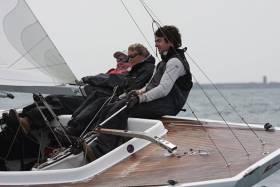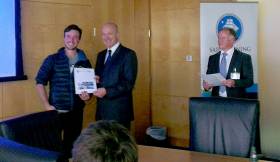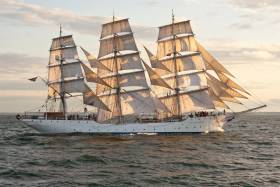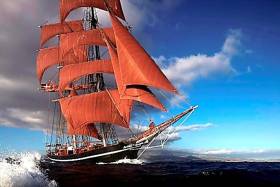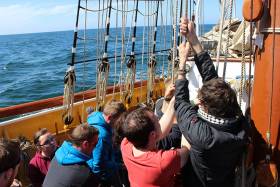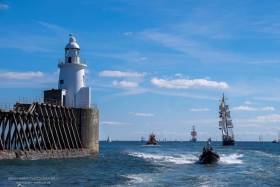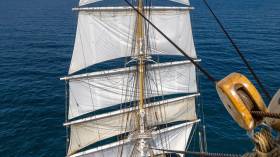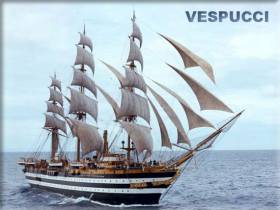Displaying items by tag: Tall Ships
Neil O’Hagan Talks Tall Ship Plans, Enda’s Vendée Globe Challenge & More At Greystones SC Next Week
#SailingTalk - The next event in Greystones Sailing Club’s Winter Wednesdays series of talks hosts Neil O'Hagan of the Atlantic Youth Trust, the project that aims to bring about Ireland's next sail training tall ship.
O’Hagan is also on-shore co-ordinator for Kilcullen Team Ireland in the Vendée Globe, and he will have all the scuttlebutt on the highs and lows of Enda O’Coineen sailing Kilcullen Voyager, Ireland’s first entry in the round-the-world solo yachting challenge.
The date for diary is next Wednesday 25 January at 8pm, bar open from 7.30pm. You won’t want to miss it!
Sail Training Ireland Trainee Awards Held At Dublin Port
Sail Training Ireland recently held an awards event to recognise recent trainees who had completed sail training voyages with the support of Dublin Port Company.
Seven trainees were presented with their awards by Dublin Port CEO Eamonn O’Reilly.
The highlight of the event was the excellent presentations by four of the trainees who told the story of their voyages and the positive impact it had on them.
These voyages were made possible by the generous support of Dublin Port Company. Both Eamonn O’Reilly and Sail Training Ireland CEO, Daragh Sheridan spoke of the fantastic relationship between the two organisations and of the positive impact on the trainees and of the importance of the presence of the tall ships at the annual Dublin Port Riverfest.
Sail Training Ireland is Ireland’s National Sail Training Organisation and a registered charity, formed in 2011 as a replacement for Coiste an Asgard. The organisation raises funds to offer sail training voyages to young people from all backgrounds and abilities on the island of Ireland.
Sail Training offers a unique and very effective means of helping young people to reach their full potential. It provides a platform for personal and group development and offers a life changing experience that sparks a new perspective to help develop essential life skills.
The skills gained and challenges faced on board are transferable to everyday life and for some it can act as a stepping stone into maritime careers.
Somme Sets Out And Stavros Sails In
#SailStavros – A French Navy fleet tanker replenishment vessel this morning departed Dublin Port and where a UK youth sail training ship arrived this afternoon, writes Jehan Ashmore.
BCR Somme (A631) is a Durance class command and replenishment ship which Afloat reported on during a another visit, click here. On this occasion,the 157m tanker had spent her Irish call having arrived on Friday to the port providing crew rest leave over the weekend.
As for the sail-trainee, Stavros S Niarchos of the Tall Ships Youth Trust, she is on a visit to the capital where some of the ferries that serve the Holyhead route share a connection with the brig, that been Stena Line. The 60m brig is managed by Northern Marine Group, a wholly owned subsidiary of Stena AB Gothenburg. The subsidiary formed in 1983 is headquartered in Clydebank, Scotland.
Trainees of the Portsmouth based brig are given duties which involves one of the three watches to operate the vessel. It's a 24 hour job and this is where they learn how to set sails of the two square-rigged masts, man the ropes, take the helm, keep a proper look-out. All these varied tasks that are involved to keep a Tall Ship sailing.
A typical cruising programme has voyages of between 2 and 12 days. This sees Stavros S Niarchos sail along the English south coast, to the Canary Islands, Azores and as far as the Caribbean.
On this Irish visit, Stavros S Niarchos headed upriver this afternoon and passed Alexandra Basin, where BCR Somme had been allocated a berth.
The final stretch of the voyage from Merseyside involved a transit of the Tom Clarke Bridge at Ringsend. The toll-lift bascule designed structure saw the lifting span (45m wide) rise, permitting the brig’s passage upriver on the Liffey.
Fully Rigged Norwegian Tallship Anchors in Cork Harbour
#Tallship - A Norwegian tallship classified as a fully rigged ship which is to celebrate its 80th anniversary next year is at anchorage in Cork Harbour today, writes Jehan Ashmore.
Christian Radich will be marking the 80th anniversary by making special commemorative voyages along the spectacular Norwegian coast.
In the meantime her visit to Cork Harbour follows sailing in UK waters and having set off almost a fortnight ago from her homeport of Oslo. She is anchored in the lower Cork Harbour between Cobh and Whitegate and is to remain until a departure tomorrow morning.
Another Norwegian tallship which is even older having been built more than a century ago in 1914 is Statsraad Lehmkuhl, which made a visit to Dublin as part of National Heritage Week in August.
The pair serve as ambassadors of the Nordic state, which has a very strong maritime tradition, notably in the energy and exploration sectors.
Operated by an Oslo based foundation, the 1937 built Christian Radich, has been preserved for future generations as primarily serving as a school ship. Setting a sail area of 1360,00 m2, the trainee ship is used for voyages for 15 trainees of all ages and is available for charter.
The services of the tallship were also used by the Norwegian Navy’s officer school, however they were unable to renew the contract with Christian Radich after April 2015, despite it been a successful collaboration.
Other clients in the form of Norwegian maritime college students have taken up sail training from September to May. It is during this current winter programme that Christian Radich is offering a week's voyage around the Canary Islands beginning next year in early January.
Looking further ahead in April, there are places for those who want to compete in a race as the Christain Radich enters the first leg in the rendez-vous of the 2017 Tall Ships Regatta. This is to take place in Greenwich, downriver of central London before heading to Canada.
Tall Ship 'Eye of the Wind' Is Ireland-Bound
#TallShips - A legendary tall ship that's featured in Hollywood movies such as White Squall and The Blue Lagoon will visit Dublin next month for the first time in 20 years.
Eye of the Wind was first built in 1911 under the name Friedrich as a cargo vessel, but the brig began its 'second maiden voyage' under its current name in 1976 after extensive renovations by a British sailing enthusiast.
Since then it's had many adventures on the high seas besides its silver screen appearances, including being the flagship for the scientific expedition 'Operation Drake' in 1978, where even patron Prince Charles took the helm for a spell.
These days, however, the distinctive tall ship rounds the world as a sail training vessel for young people aged 16 to 25, captained for the last seven years by Swiss skipper Cornel Greth - who's determined to make new memories for this more than a century old shining example of sailing history.
“Before 2009, the Eye of the Wind sailed under various owners,” he says. “That’s why there is no complete documentation of all past trips recorded in our logbooks.
"We assume that the last voyage to Dublin dates back to 1996, when the crew at that time sailed from Bristol to the '50 Years of the Irish Navy' weekend.
"Certainly the forthcoming journey to the coast of Éire must be the first one of its kind in nearly two decades.”
Eye of the Wind is set to arrive in Dublin on Wednesday 5 October after a one-week crossing of the Irish Sea from Oban in Scotland. Following a two-day stopover, the captain and trainee crew will sail on to the Netherlands, Spain and the Canary Islands.
For more details see www.eyeofthewind.net
Tall Ship Celebrations for Cork Sail Training Bursary Scheme
32 young people from all backgrounds and a range of abilities across Cork City and County who have completed Tall Ship voyages aboard the Cork-Based Vessel Spirit of Oysterhaven and the Dutch Tall Ship Morgenster during the 2016 season will celebrate their achievements in Cork today.
The voyages were made possible by the assistance of a group of sponsors including Port of Cork, Cork City Council, Cork County Council, EMC, Ardmore Shipping, The Institute of Master Mariners and the National Maritime College of Ireland.
Due to extra support from Port of Cork, Cork County Council and Cork City Council Morgenster made a visit to Cork in June and hosted events and “open-ship” for public visits in Cork City and in Cobh during the Cork Harbour Festival 2016.
13 trainees from the City and County sailed the ship over 12 days from Belfast, via Isle of Man to Cork. Another 3 Cork trainees sailed from Cork to Amsterdam over 19 days arriving in Amsterdam at the end of June. These trainees formed part of groups with up-to 32 trainees and mentors on each voyage which were part funded using EU “Erasmus +” funding and involved active educational programmes of youth development as part of “Youth Exchange” projects.
The Cork Sail Training Bursary Scheme was established in 2014 to provide access to Sail Training voyages on tall ships and large sailing vessels for young people from the region. Now in its third year the scheme is one of the largest and most active on the Island of Ireland and runs in parallel with similar schemes now in operation under Sail Training Ireland in Belfast, Drogheda, Dublin, Waterford, Wexford, Limerick and Galway. The participants are nominated through a network of youth and community groups in Cork and places are available to young people from all backgrounds and with all abilities.
The scheme has supported approximately 50 trainees since 2014 and looks likely to grow from strength to strength over the coming years.
Also present on the day will be trainees sponsored under one of Sail Training Ireland’s “SafeHaven Voyages” sponsored by “Arthur Cox”. Their voyage on board the “Spirit of Oysterhaven” finishes today, following six days at sea beginning in Glandore County Cork. The vessel will be in Port of Cork and open to visitors after the event.
“The whole experience since we first met until the last moment I will never forget. The scenery, the sea sickness, the lifestyle and most of all the people I spent this journey with. I’ve made some lovely friends and will never forget them.” Cork Trainee 2015.
MC for the event is RTE Radio “SeaScapes” Presenter Marcus Connaughton (Goodwill Ambassador for Sail Training Ireland) and the certificates will be presented to trainees by Commodore Hugh Tully - Flag Officer Commanding Naval Service (F.O.C.N.S.). The Naval Service is a strong supporter of Sail Training for young people as a stepping stone into maritime careers and has recently made the Naval Yacht “Creidne” available for voyages for young people selected by Sail Training Ireland.
Irish Bulker Berths at Blyth Host of Tall Ships Race Diamond Anniversary
#TallShipsRace - Bulker Arklow Meadow departed Aughinish, Shannon Estuary last week bound for the Port of Blyth, where the UK port was host to the North Sea Tall Ships Race, writes Jehan Ashmore.
The Irish flagged Arklow Meadow had loaded at the Rusal Aughinish Alumina plant (see: sister report) from where the 'M' class 14,990dwt bulker departed to round Scotland. The bulker discharged at Blyth where the north-east English port has the Alcan Aluminium Ore Unloading Facility. The South Korean built bulker currently remains at this berth.
At the Northumberland port a spectacular line-up of around 30 entrants of the North Sea Tall Ships regatta gathered for the Parade of Sail and which this year celebrated a Diamond anniversary of the Tall Ships race movement. The North Sea event followed that of the main Tall Ships Race 2016, the prestigious annual race which is also organised by Sail Training International.
It is exactly sixty years since the very first Tall Ships Race visited Lisbon, Portugal in 1956 - an international fleet aptly made a return visit this year, having set off from Antwerp, Belgium. The winner of the Tall Ships Race 2016 was Norway’s Statsraad Lehmkuhl as previously reported on Afloat.ie which visited Dublin Port last month after a cruise-in company to Coruña, northern Spain.
Last week’s sailing spectacular of the North Sea Tall Ships Parade of Sail was held in glorious conditions on the UK’s Bank Holiday at the end of August. As the magnificent tallships departed the Port of Blyth, the Parade of Sail was observed by spectators lining the decks of Princess Seaways, a ferry operated by the Parade sponsor, DFDS Seaways. The Danish shipping company also had something to celebrate, as 2016 marks their 150th anniversary.
Princess Seaways, made the special four-hour cruise to Blyth from Newcastle, further south along the coast. Otherwise the 31,000 gross tonnage ferry normally operates the Newcastle-Amsterdam (Ijmuiden) along with route partner and a sister, King Seaways. The former Val de Loire served Brittany Ferries seasonal Cork-Roscoff route until replaced by current incumbent, Pont-Aven that entered service in 2004 (this year installed with 'scrubbers'). The flagship also operates year round on France-UK and UK-Spanish routes.
Among the North Sea Tall Ship Races participants that were observed from the ferry's cruise, was another Norwegian entrant, Christian Radich, Poland’s Dar Mlodziezy, the UK’s Lord Nelson and the Dutch Morgenster, a visitor to this summer’s Dublin Riverfest.
At the weekend the Tall Ships had completed the 500 nautical mile leg from Blyth having arrived at the Swedish Port of Gothenburg culminating the North Sea Tall Ships Race. This was the fifth occasion that Gothenburg has hosted the Tall Ships.
#SuperyachtEOS – One of the world’s largest privately owned superyachts, Eos that sailed to Cork Harbour earlier this summer has since among her worldwide cruising grounds called to Scotland and recently to the Croatian Riviera, writes Jehan Ashmore.
The majestic three-masted Bermuda rigged schooner, Eos, named after ancient Greek goddess, is understood to be owned by American media and television executive Barry Diller.
Eos is ranked in the Top 100 superyachts (including motor-only) and despite been built a decade ago she still holds a credible 48th position. She had sailed to Cork Harbour from the St. Johns Antigua in the Caribbean via the Azores to arrive alongside Cobh’s cruiseship pontoon. After her Irish stopover visit she then headed to Scotland (Caledonia), the latin name given by the Romans.
The impressive Eos built by Lurssen Yachts in Bremen, Germany, has accommodation with interiors designed by François Catroux, to pamper 16 owner/guests served by 21 crew. At almost 93 metres long, she weighs 1,500 tonnes and all three masts tower 61m above the waterline, in addition each mast alone is complete with a pair of satellite communication domes.
As reported by Eddie English during her quayside call in Cobh (schroll down for video) the schooner is also seen above entering Brodick Bay, Arran, largest and nearest of the Caledonian /West Scottish isles to Ireland. Eos following her visit to Cobh, had continued to Greenock on the Firth of Clyde, the container and cruiseship port for Glasgow.
It was only a few hours after arriving at Arran, dubbed Scotland in miniature (see CalMac ferry excursions) that Eos was observed under motor at slow speed approaching anchorage in Brodrick Bay where the ferryport is located. To further emphasis how long Eos is, the local Brodick-Ardrossan ferry, the 1,000 passenger/120 car Caledonian Isles is 94.30m, marginally longer than the schooners 92.92m, however, she beats smaller ferrymate, Isle of Arran that also plies the seasonal-only Ardrossan-Campbeltown, Kintyre route that runs up to 25 September.
Eos was escorted into a balmy Brodick Bay by her equally matching hull coloured tender. She joined the weekend-visiting yachts that lay at anchor against the scenic backdrop of Goat Fell, the island’s highest peak.
The Caymen Islands flagged schooner is now in more, sunnier climes in the Adriatic Sea, having called to Dubrovnik, Croatia Riviera this week. The numerous Croatian isles outnumber those of Scotland, as they too prove a big attraction for the privately owned superyachts, but also tourists taking cruiseships to the medieval coastal city that strictly controls their calls.
Dubrovnik, is also where the Cork connection continues, albeit not strictly superyacht related, but that of one of the more humble local based car-ferries. That been a ferry of the city’s namesake, the Irish built Dubrovnik, launched at the Verolme Cork Dockyard, Rushbrooke in 1979 as B+I Line's Connacht.
She made her maiden sailing on the Cork-Swansea, Wales route that year and after a spell as Brittany Ferries Duchesse Anne, she moved to operator, Jadrolinija on the Dubrovnik-Bari, Italy route.
Norwegian Tallship Open to Visitors During Heritage Week
#HeritageVisitor - A Norwegian tall ship, Statsraad Lehmkuhl is calling to Dublin Port as part of Heritage Week, and will be open for visitors.
Statsraad Lehmkuhl will be docked at Sir John Rogerson’s Quay, where on Saturday 20 August, one of the world’s biggest tallships will be open to the public between 2 and 4pm. No booking is required nor no fee to gain admission on board what is also one of the oldest of the world’s square rigger ships.
Due to extensive conservation work over the last few decades, the Statsraad Lehmkuhl still looks almost as it did when it was completely new more than a hundred years ago, and a visit on the ship is therefore like taking a step back in time.
Statsraad Lehmkuhl will sail to Dublin from A Coruña, northern Spain where it recently became the winner of Tall Ship Races 2016. The ship will depart Dublin on Sunday 21. August and sail back home to Bergen, Norway, a journey that will take five days.
Statsraad Lehmkuhl was built in 1914, in Bremerhaven-Geestemünde in Germany, as a training ship for the German merchant marine.
In 1923, the ship was bought by “Det Bergenske Damskipsselskap” (Bergen Steamship Company), and renamed “Statsraad Lehmkuhl” (Minister Lemhkuhl) after the man responsible for securing it.
Statsraad Lehmkuhl was used as a training vessel for Bergen School Ship Foundation until 1967, except for a brief interval during World War II when it was confiscated by Germany.
Later on, the ship was donated to the Statsraad Lehmkuhl Foundation, which is the current owner and operator of the ship.
Over the years, the Foundation has arranged cruises and coastal trips that are open for the public to attend. In addition, Statsraad Lehmkuhl has often been rented out to schools, companies, clubs and organisations that have used the ship for shorter trips.
In recent years, Statsraad Lehmkuhl has become a familiar sight in the Bergen harbour, blending in seamlessly with the colourful wooden houses at “Bryggen”.
85 Year Old Italian Navy Cadet Tall Ship On Visit to Dublin Port
#Tallship@85 - An 85 year-old Italian Navy school tallship that always draws a big crowd during the Tall Ships Races, which this year sees a North Sea Regatta call to the UK later this month, is currently on a three-day visit to Dublin Port, writes Jehan Ashmore.
The pride of the Italian Navy the cadet trainee tallship Amerigo Vespucci, a full rigged three mast ship visited Dublin during the capital’s hosting of the Tall Ships Races this month four years ago.
The 2012 Races saw the distinctive sounding named vessel berth along Sir John Rogersons Quay, however compared to the line-up of other visiting white hulled vessels, she notably stood out. The ships unusual black and white stripped hull and gold decorative artwork adorning her bow all adds to a sense of style.
She is on her 80th training campaign for Cadets of the Italian Naval Academy, after departing Livorno, on the Tuscan coast last month with 100 cadets. The sail programme will cover the Western Mediterranean, Atlantic Ocean, North Sea and to Scandinavia. So far she has visited Cadiz, Spain.
On this occasion, Amerigo Vespucci, yesterday docked in Dublin Port under command Captain Curzio Pacifici and initially berthed at Alexandra Basin west. This was a rather unusual berth allocation for this type of ship. Only the masts and bowsprit were visible from the Poolbeg Yacht & Boat Club, Ringsend.
Afloat can confirm that Amerigo Vespucci has since shifted berths and is today berthed along Sir John Rogersons Quay. According to italvideonewstv.net, the tallship is open to the public for viewing with the following schedule:
Beginning today, Wednesday, 10th August: 16.00-18.30 and 20.00-21.30
Thursday, 11th August: 10.30-12.00 and 14.30-17.00
Friday, 12th August: 10.30-12.00 and 14.30-17.00
Following her Irish port of call, the sail programme will include visits to Oslo, Copenhagen, Antwerp, Brest and Valencia.
The tallship is due to return to Livorno on 1st October.


























